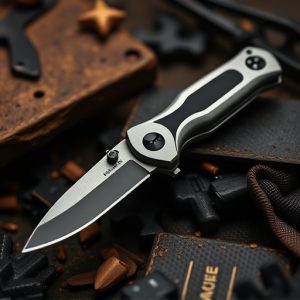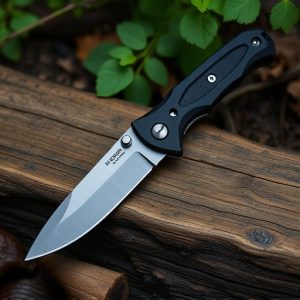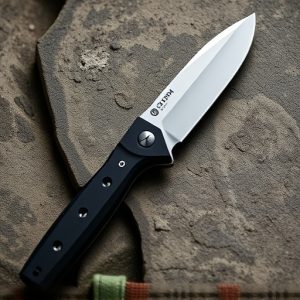Mastering the OTF Automatic Knife: A Comprehensive Guide to Function, Features, and Legal Use
An OTF (One-Time-Flip) automatic knife is a cutting-edge tool that seamlessly blends traditional bl…….
An OTF (One-Time-Flip) automatic knife is a cutting-edge tool that seamlessly blends traditional blade craftsmanship with advanced technology. It features a swift and reliable deployment mechanism for immediate cutting capability, often powered by a torsion bar or coil spring system. These knives are particularly useful in outdoor and professional settings due to their quickness and robust design, which is a testament to human ingenuity and precision engineering. The ergonomic handle ensures user safety, durability, and efficient functionality, while the balance between the handle and blade allows for effortless operation and precise control. Available in various designs, OTF automatic knives are suited for tasks ranging from self-defense to survival scenarios. They are subject to strict legal regulations, notably under the National Firearms Act of 1934, which classifies them as firearms and requires extensive background checks and a tax stamp for ownership. Proper maintenance, including regular cleaning, lubrication, and inspection, is essential to maintain their reliability and longevity. For those interested in these knives, it's important to be well-versed in the legal implications of ownership and to follow the manufacturer's guidelines for care and storage to ensure both the knife's performance and personal safety.
Ot delineates the evolution of personal defense mechanisms, with the OTF (Out-The-Front) automatic knife standing at the cutting edge of this transformation. This article dissects the intricacies of the OTF automatic knife, from its seamless blend of tradition and modern innovation to the practicalities of its maintenance. We’ll explore its unique mechanism, navigate the legal landscape it inhabits, and guide you through selecting a robust model that matches your needs. Whether for self-defense or tactical applications, understanding an OTF automatic knife is paramount for enthusiasts and practitioners alike.
Understanding the OTF Automatic Knife: A Blend of Tradition and Modernity
An automatic OTF, or One-Time-Flip, knife represents a fascinating convergence of traditional knife craftsmanship and cutting-edge technology. This sophisticated tool is designed to deploy its blade with a single flip of a lever, providing users with immediate access to a sharp edge for various tasks. The mechanism at the heart of the OTF automatic knife is both intricate and reliable, hinging on a torsion bar or a coil spring that propels the blade outwards upon activation. This seamless deployment makes it an invaluable tool for outdoor enthusiasts, law enforcement officers, and professionals who require a swift response in challenging environments.
The OTF automatic knife stands as a testament to human ingenuity in the field of mechanical design. Each component within this device, from the pivot point to the locking system, has been meticulously engineered to ensure safety, durability, and functionality. The balance between the handle and blade is crucial for effective use, allowing for smooth operation and precise handling. With advancements in materials science and engineering, these knives are not only more robust but also come in a variety of configurations suited to different user preferences and applications. Whether for self-defense, survival situations, or everyday carry, the OTF automatic knife offers users a blend of tradition, with its straightforward flipping action, and modernity, with its high-tech construction and ergonomic design.
The Mechanism Behind the OTF Automatic Knife: How It Functions
An automatic opening tactical folder, commonly known as an OTF (Out-The-Front) knife, is a marvel of engineering and design. The mechanism behind this sleek and swift device is both intricate and efficient. Upon activation, typically through a button located on the handle or trigger near the pivot point, a compressed spring or compressed gas system propels the blade forward with remarkable speed and precision. This motion extends the blade from its retracted position to its full deployed length, ready for immediate use. The OTF automatic knife is equipped with a series of ball bearings or rollers that guide the blade’s smooth and rapid movement during deployment. This ensures that the blade opens cleanly and without obstruction, making it a reliable tool in various situations where quick access to a sharp edge is paramount.
The design of an OTF automatic knife is such that it integrates both the spring or gas system and the blade within the handle. The blade itself is often concealed within the body of the handle until activation. This design choice not only ensures the blade remains out of sight, reducing the risk of accidental deployment but also protects the mechanism from dust and debris when the knife is carried or stored. The handle, crafted for ergonomic comfort, provides a secure grip during operation, ensuring that the user can actuate the knife with confidence and control. The OTF automatic knife’s functionality lies in its simplicity, reliability, and the speed at which it can be deployed, making it an essential tool for professionals who require a rapid response in high-stress environments, as well as a novelty for collectors and enthusiasts of cutting-edge (pun intended) technology.
Legal Considerations and Regulations Governing OTF Automatic Knives
In the realm of pocket knives, the OTF automatic knife, often abbreviated as OTF for One-Time-Flip, stands out due to its distinctive mechanism that deploys the blade with a single motion. While their deployment is swift and efficient, the legal considerations and regulations governing these devices are complex and vary by jurisdiction. It’s imperative for potential owners to be well-versed in local laws before acquiring an OTF automatic knife. In the United States, the federal law under the National Firearms Act of 1934 categorizes such knives as firearms due to their ability to be readily converted to a pistol configuration. Consequently, they are subject to stringent regulations, including thorough background checks and a tax stamp. State and local laws may further dictate permissible uses, open carry versus concealed carry, and restrictions on certain types of OTF knives based on blade length or design. The ATF, or Bureau of Alcohol, Tobacco, Firearms and Explosives, provides guidance and clarification on the legality of these knives, emphasizing the importance of compliance to avoid legal repercussions. Users must navigate these regulations diligently to ensure they are in full compliance with all applicable laws.
Features to Look for in an OTF Automatic Knife: Design, Material, and Performance
When considering an OTF automatic knife for your collection or as a tool, it’s crucial to evaluate several key features that contribute to its design, material composition, and overall performance. The design of an OTF automatic knife is paramount, as it dictates the ease of use, ergonomics, and aesthetic appeal. Opt for a model with a streamlined profile that fits comfortably in your hand, and features an ambidextrous design if you plan to share or use it in various situations. The blade deployment mechanism should be smooth and reliable, ensuring swift activation without accidental activations.
Moving beyond aesthetics, the material from which the knife is constructed plays a significant role in its durability and functionality. High-quality stainless steel is often preferred for its resistance to corrosion and ability to maintain an edge. Look for knives with high-end steel alloys like titanium nitride or surgical-grade stainless steel, which provide exceptional strength and resistance to wear. Additionally, consider the performance aspect, which encompasses the knife’s speed, reliability, and precision. A top-tier OTF automatic knife should boast a robust and reliable spring system that ensures consistent and rapid deployment. The bearing system within the blade should be smooth and resistant to dirt and debris for seamless operation in various conditions. Whether for tactical applications or everyday carry, an OTF automatic knife’s effectiveness is contingent on these critical features, ensuring it remains a dependable tool for a multitude of tasks.
Maintenance and Care for Your OTF Automatic Knife: Ensuring Longevity and Precision
The maintenance and care of an OTF (One-Time-Fly or Out-The-Front) automatic knife are critical for preserving its longevity and maintaining its precision. To ensure your OTF automatic knife performs optimally over time, it’s imperative to follow a routine cleaning and lubrication schedule. The mechanisms within an OTF knife, particularly the spring-driven blade that deploys at the push of a button, are intricate and require careful handling. After each use, especially if used in challenging environments or conditions that may cause debris accumulation, disassemble the knife meticulously. Use a soft cloth to remove any visible dirt or grime from both the blade and the body. Employ a cleaner specifically designed for firearm maintenance or a mild soap solution to avoid damaging any components. Once cleaned, apply a lubricant sparingly to the pivot points and moving parts as per the manufacturer’s guidelines. This will help prevent corrosion and ensure smooth operation. It’s also advisable to inspect the knife regularly for signs of wear or damage. Keep an eye on the blade deployment mechanism, ensuring it operates with consistent force and returns smoothly into its housing. By adhering to these maintenance practices, your OTF automatic knife will remain a reliable tool, ready for use whenever necessary. Remember to store your knife responsibly when not in use, away from unauthorized users to maintain safety and ensure the blade remains intact. Regular maintenance is key to prolonging the life of your OTF automatic knife and keeping it functioning with precision.


